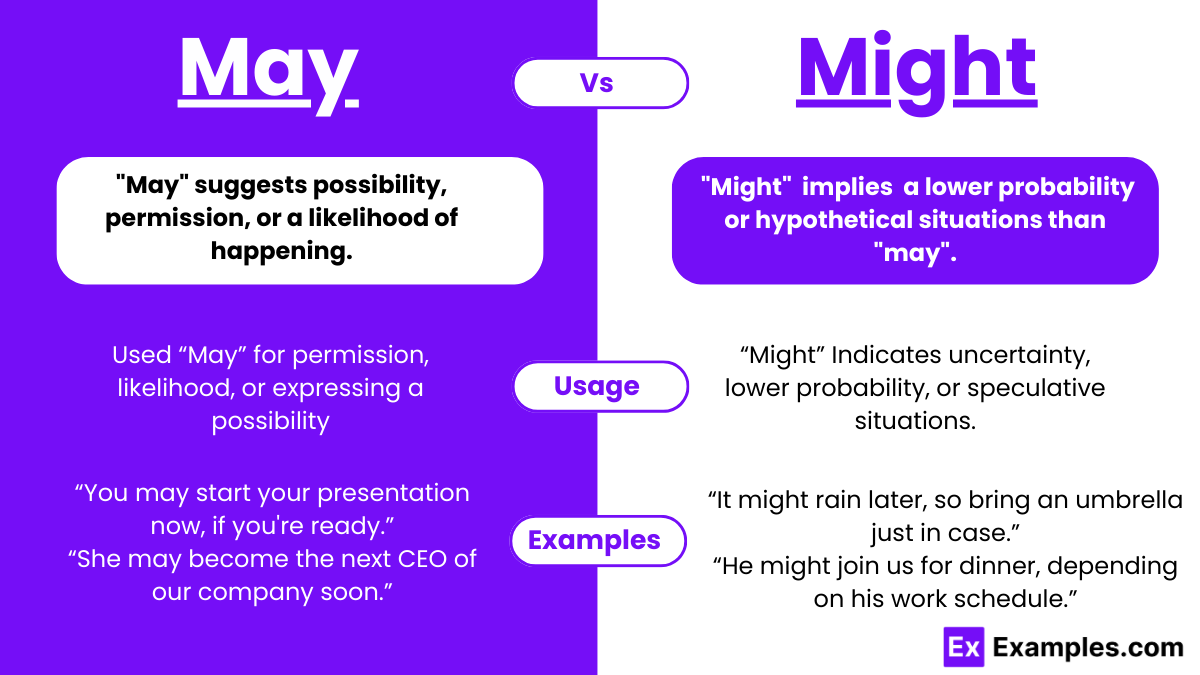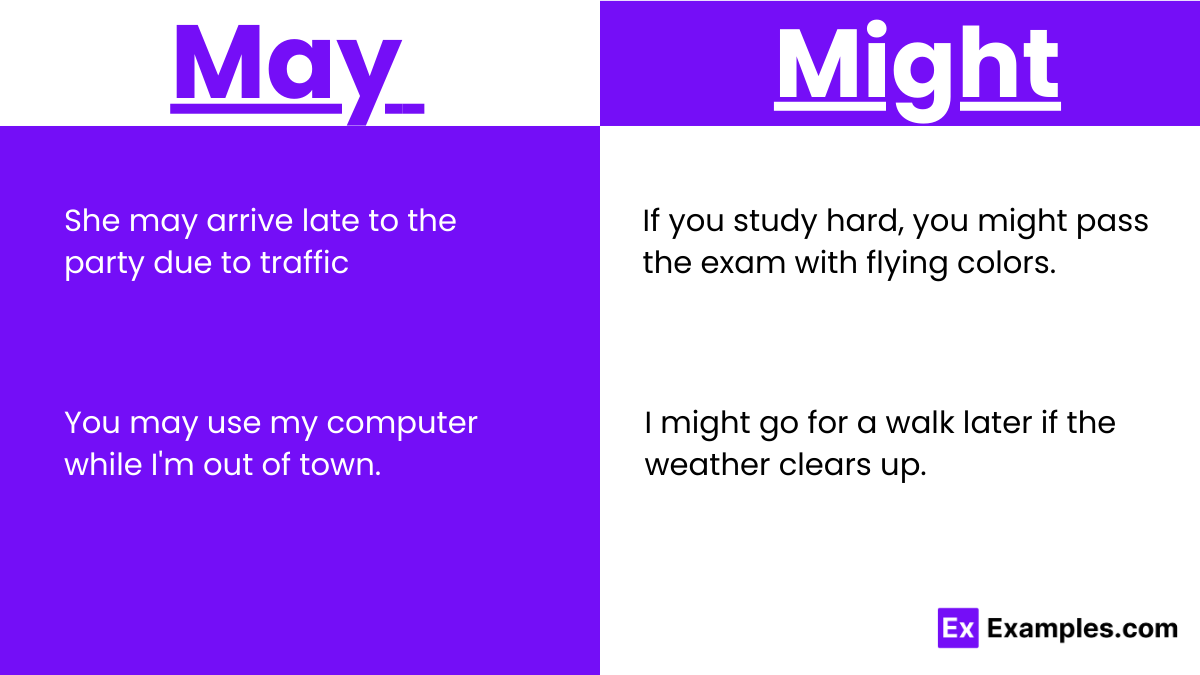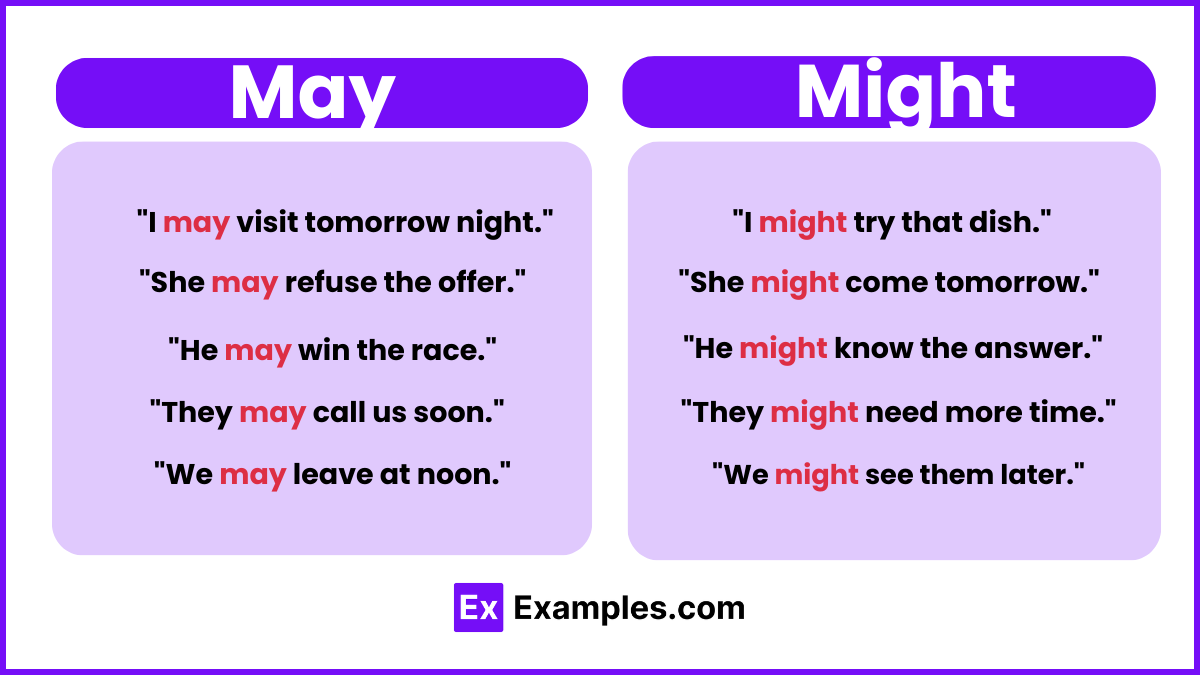May vs Might – Examples, Differences, Usage, Tricks
Embarking on the journey through the English language reveals a landscape rich in nuances, where the mastery of modal verbs like “may” and “might” becomes a cornerstone of eloquent expression. These two small words, often overlooked, hold the power to unlock worlds of possibility, speculation, and politeness in our daily conversations and written discourse. For students venturing into the depths of English grammar, understanding the subtle differences between “may” and “might” is not just an academic exercise; it’s a key to communicating more effectively, with precision and nuance.
“May and Might” – Meanings
May: “May” is a modal verb used to express possibility, permission, or to make a polite suggestion. It indicates something is likely to happen or is allowed. In formal contexts, “may” also conveys a wish or hope, embodying a tone of respect or formal permission.
Might: “Might” is a modal verb similar to “may” but implies a lower probability. It’s used to express uncertainty, speculative scenarios, or hypothetical situations. “Might” often appears in conversations about events that are possible but less certain, providing a nuanced way to discuss potential outcomes
Summary of May and Might
“May” and “Might” are modal verbs used to express possibility, with “may” suggesting a higher likelihood compared to “might”. Both are essential for polite requests or speculative statements, but “may” is more formal, often seen in written language, while “might” is commonly used for lower probabilities and in more informal contexts. Understanding their nuances enhances clarity and precision in English communication.
How To Pronounce May and Might
For “May”:
- Start with the “m” sound by pressing your lips together.
- Open your mouth slightly to form the “ay” sound, similar to “say”.
For “Might”:
- Begin with the “m” sound, lips together.
- Transition to the “ai” sound, as in “high”.
- End with a soft “t”, tongue touching the roof of your mouth briefly.
Difference Between May and Might
| Aspect | May | Might |
|---|---|---|
| Likelihood | Suggests a higher chance of occurrence. | Implies a lower probability. |
| Formality | More formal, often used in written requests. | Less formal, commonly used in speech. |
| Time Reference | Can be used for present or future possibilities. | Often used for hypothetical situations, regardless of time. |
| Permission | Frequently used to ask for or give permission. | Less commonly used for permission. |
| Speculation | Used for speculating about present or future events. | Used for more uncertain speculation. |
| Past Possibility | Not used to express past possibilities directly. | Can indicate a past possibility in a more speculative way. |
| Politeness | Considered slightly more polite or formal. | Seen as more casual or informal. |
| Negative Form | “May not” suggests something is unlikely but possible. | “Might not” implies greater uncertainty. |
| Affirmative Form | Used to express a polite affirmation. | Indicates a less certain affirmation. |
| Conditional Sentences | Rarely used in conditional sentences. | Common in conditional sentences for less likely scenarios. |
Tricks to Remember May and Might
- May for Permission: Use “may” when asking for or granting permission in a formal context.
- Might for Less Certainty: Opt for “might” when expressing doubts or less likelihood.
- May in Formal Writing: Prefer “may” for formal requests or written documents.
- Might for Speculative Past: Use “might” to speculate about past events with uncertainty.
- May for Probable Actions: Choose “may” when an action is probable in the present or future.
- Might for Hypotheticals: “Might” is ideal for hypothetical situations or conditions.
- Negative Forms: Remember, “may not” implies possibility, whereas “might not” suggests stronger doubt.
- Time Tense: Use “may” for present/future and “might” for any speculative situation.
- Conditional Clauses: “Might” is preferable in the second conditional for unreal or unlikely scenarios.
- Politeness Levels: “May” is your go-to for a slightly more formal or polite tone.
For the rest of your request, it appears there might be a mix-up in the topics (switching between “Could vs Would” and “May vs Might”). Please clarify which topic you’d like to continue with, or if you need assistance on another topic altogether
When to Use May and Might
May:
- For a higher probability situation.
- When asking for permission formally.
- In formal or official contexts.
- For present or future possibilities.
- To express a wish or hope.
Might:
- For lower probability or more uncertainty.
- In speculative or hypothetical scenarios.
- When reflecting on past possibilities.
- In informal contexts or conversations.
- To softly suggest or advise.
How to Use May and Might
May:
- “May I leave early today?” – Asking permission.
- “It may rain later.” – Predicting weather.
- “You may find this interesting.” – Suggesting politely.
- “May we suggest a break?” – Offering advice formally.
- “She may join us later.” – Indicating possibility.
Might:
- “I might go to the party.” – Indicating uncertainty.
- “He might have known.” – Speculating about the past.
- “Might I suggest an alternative?” – Offering a suggestion politely.
- “They might not agree.” – Expressing a doubtful outcome.
- “It might be easier this way.” – Suggesting a possibility.
May and Might Examples
May:
- “May I speak now?”
- “We may leave early.”
- “You may be right.”
- “It may happen tomorrow.”
- “She may know the answer.”
Might:
- “I might try that.”
- “They might come later.”
- “He might not agree.”
- “She might have forgotten.”
- “It might not work.”
Synonyms For May and Might
| May | Might |
|---|---|
| Could | Could |
| Is able to | Is possibly |
| Is permitted to | May well |
| Has the chance to | Has the possibility |
| Is likely to | Is conceivable |
| Possesses the opportunity to | Possesses the potential to |
| Is authorized to | Is feasible |
| Has the option to | Has a slight chance of |
| Is capable of | Is thinkable |
| Is entitled to | Is within the realm of possibility |
Fill in the Blank with the Correct Form of “May and Might”:
- She _______ come to the party.
- It _______ rain tomorrow.
- _______ I use your phone?
- They _______ not understand the instructions.
- He _______ have taken the wrong train.
- You _______ want to reconsider your decision.
- _______ we begin the meeting now?
- This strategy _______ work, but it’s risky.
- I _______ be a few minutes late.
- We _______ see improvements by next quarter.
Answers:
- might
- may
- May
- might
- might
- might
- May
- might
- might
- may
Understanding the nuanced differences between “may” and “might” enriches our ability to express probability, permission, and speculative thoughts with greater precision. “May” often suggests a higher likelihood or formal permission, while “might” leans into uncertainty or hypotheticals, offering flexibility in our expressions. Mastering these distinctions not only clarifies our intentions but also polishes our communication, making it apt for a variety of contexts




